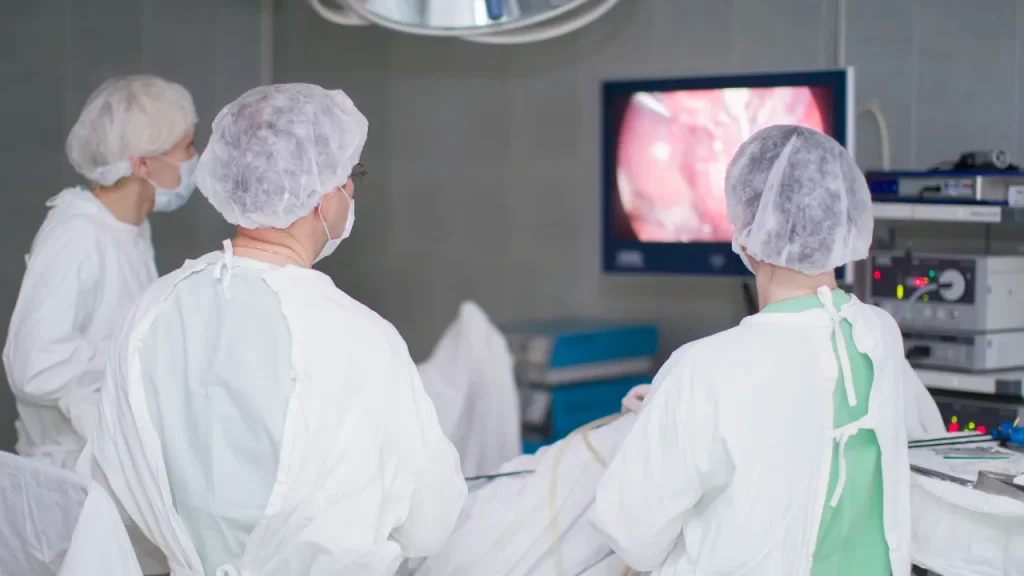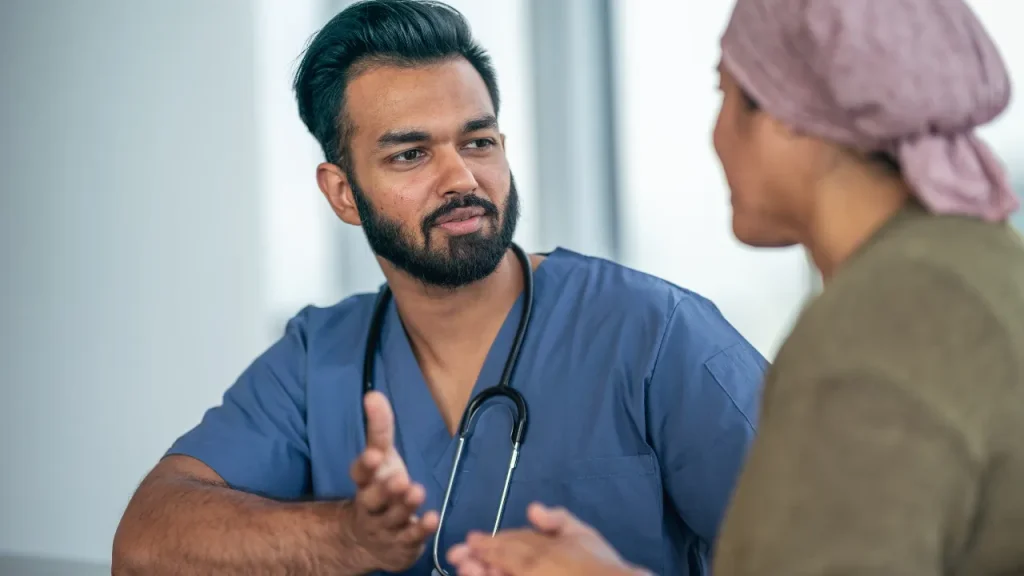Introduction
Diagnostic laparoscopy stands out as a key tool in this effort. This procedure lets doctors look inside the abdomen with small cuts. It helps find problems that other tests miss. In this article, we explain when and why we suggest this method. We base our advice on proven medical facts from reliable sources.
What Is Diagnostic Laparoscopy?

Diagnostic laparoscopy uses a thin tube with a camera to check the abdomen. Doctors insert this tube through a small cut near the belly button. They add gas to the belly to create space. This setup gives a clear view of organs like the liver, stomach, and intestines. The camera sends images to a screen. Doctors watch these images to spot issues.
In India, we perform this procedure in hospitals and clinics across cities like Mumbai, Delhi, and Chennai. It fits well with our healthcare system, where quick diagnosis matters due to high patient numbers. Unlike open surgery, it needs only tiny cuts. This reduces recovery time and hospital stays. We use it mainly to diagnose, but sometimes to treat small problems right away.
When Do We Recommend Diagnostic Laparoscopy?
We recommend diagnostic laparoscopy for specific situations. Patients often come to us with belly pain that lasts weeks or months. If X-rays or ultrasounds fail to show the cause, this procedure steps in. It finds hidden issues that other tests overlook.
One common reason involves chronic belly pain. In India, many people suffer from this due to infections or poor diet habits. For instance, pain from appendicitis or adhesions shows up clearly during the procedure. Adhesions form scar tissue that sticks organs together. They often result from past infections or surgeries. We see this in patients who have had conditions like tuberculosis, which remains common in our country.
Another case arises with abdominal masses. If scans detect a lump but cannot confirm if it is cancer or benign, laparoscopy provides answers. Doctors take tissue samples for tests. This helps in the early detection of tumours. In Indian settings, where liver diseases like hepatitis spread easily, we use it to check liver masses. It confirms if a mass needs further treatment.
We also suggest it for fluid buildup in the belly, known as ascites. This happens in liver problems or infections. Laparoscopy identifies the source, such as tuberculosis or cancer spread. In our experience, it prevents delays in treatment for these serious issues.
Women in India often face pelvic pain from conditions like endometriosis or ovarian cysts. Endometriosis affects many due to factors like stress and lifestyle. We recommend laparoscopy to view the pelvis and confirm these problems. It checks the fallopian tubes and ovaries directly. This proves vital for fertility issues, which concern many families here.
In acute cases, like sudden belly pain after an injury, we use it to spot internal bleeding or organ damage. Road accidents in India lead to many such emergencies. The procedure finds injuries fast without large cuts.
For cancer staging, laparoscopy assesses how far the disease has spread. In cases of stomach or ovarian cancer, common in our population, it guides treatment plans. We avoid unnecessary big surgeries this way.
Why Do We Recommend It?
We recommend diagnostic laparoscopy because it offers clear benefits. It provides direct views of organs, which beats indirect tests like CT scans. Scans sometimes miss small details, but laparoscopy shows them live.
In India, where healthcare costs matter, this method saves money. It shortens hospital stays to one or two days. Patients return to work sooner, which helps families. Recovery happens faster than with open surgery. Scars stay small, reducing infection risks in our warm climate.
The procedure aids in quick decisions. If doctors find a problem, they often fix it during the same session. For example, they remove cysts or adhesions without extra operations. This efficiency fits our busy hospitals.
We value its safety. Studies show low complication rates, around 4 to 5 per 1,000 cases. It avoids the pain and risks of larger surgeries. In chronic pain cases, it confirms diagnoses that have lingered uncertain for months.
Compared to waiting and watching, laparoscopy acts faster. Observation delays treatment, but this method resolves doubts promptly. It proves superior for unclear abdominal issues.
How Does the Procedure Work in India?

we follow standard steps for diagnostic laparoscopy. Patients receive general anaesthesia to sleep through it. This ensures no pain. We make a small cut below the belly button. A tube inserts carbon dioxide gas to lift the belly wall. This creates room for viewing.
Next, we place the laparoscope through the cut. It carries a light and a camera. Additional small cuts allow tools for biopsies or checks. Doctors examine organs like the appendix, gallbladder, and uterus. If needed, they inject dye to view the tubes clearly. The whole process takes 30 to 90 minutes.
Preparation for the Procedure
Patients prepare carefully for diagnostic laparoscopy. We advise fasting for 8 hours before. This empties the stomach and reduces risks. Stop blood-thinning medicines a few days prior, after consulting us. We check for allergies or health issues like obesity, which might affect the process.
In India, we stress quitting smoking, as it slows healing. For those with chronic conditions like diabetes, common here, we adjust medicines. Family support helps, especially in arranging transport home. Driving remains unsafe right after.
We explain the process in simple terms. Patients sign consent forms. Blood tests and scans happen beforehand to plan safely.
What Happens During and After?
During the procedure, patients lie on a tilted table. Anaesthesia relaxes muscles. Doctors monitor vital signs. The gas inflates the belly slightly, but we remove it at the end.
Afterwards, patients feel some soreness at the cut sites. Gas might cause shoulder pain, but it fades in hours. We give pain relief medicines. Most go home the same day or the next. Rest for a few days follows. Avoid heavy lifting.
In Indian homes, light activities like walking help recovery. We suggest a simple diet, avoiding spicy foods that irritate the belly. Yoga poses, gentle ones like child’s pose, aid in easing discomfort. We avoid recommending foreign practices; yoga fits our culture well.
Risks and Complications
Every procedure carries risks, and we discuss them openly. Infection at cut sites occurs rarely. We give antibiotics to prevent it. Bleeding or organ punctures happen in a few cases, about 1 in 1,000. If they do, we switch to open surgery.
Gas can enter the wrong places, but this remains uncommon. Patients with past surgeries or obesity face higher risks due to scar tissue. We screen for these beforehand.
In India, we monitor for issues like fever or swelling post-procedure. Call us if pain worsens or wounds redden. Quick action prevents problems.
Recovery and Follow-Up

Recovery from diagnostic laparoscopy proceeds smoothly for most. Patients resume normal eating in a day. Work returns in a week, less than with open methods. Scars heal in two weeks.
We schedule follow-ups to discuss findings. If tests show issues like cysts, we plan the next steps. For chronic pain relief, many report improvement after diagnosis and treatment.
In our practice, patients integrate recovery with daily life. Light exercise, like walking in parks, boosts healing. We advise against strenuous tasks until cleared.
Benefits
In India, diagnostic laparoscopy transforms care. Our dense population means quick tools save lives. It handles common issues like gallbladder stones or pelvic infections efficiently. Women benefit from their role in fertility checks, addressing societal needs.
It reduces unnecessary surgeries. Studies in Indian hospitals show it avoids laparotomy in up to 50% of unclear cases. This lowers costs and risks.
We see it as a bridge between tests and treatment. For rural patients travelling to cities, one procedure often suffices. It aligns with our goal of accessible healthcare.
Conclusion
Diagnostic laparoscopy serves as a reliable option when we need clear answers. Its benefits include speed, safety, and cost savings in our Indian context. Patients gain from minimal invasion and fast recovery. We stand by this method with calm confidence, backed by evidence. If symptoms persist, consult us for guidance. Early action leads to better outcomes.
